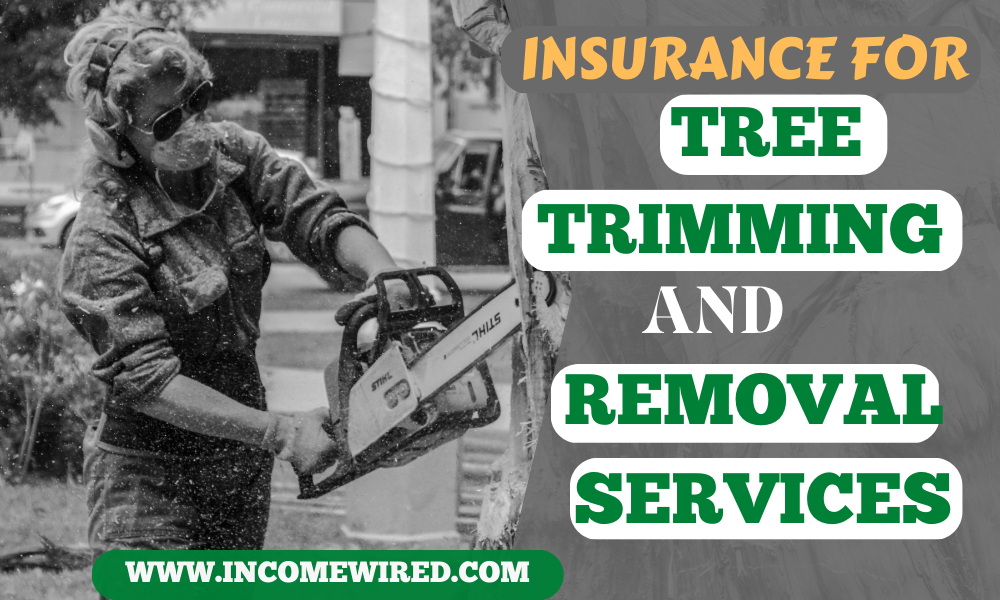we help service-based business owners, freelancers, and aspiring businesses with our content & services & When readers purchase services discussed on our site, we often earn affiliate commissions that support our work. Find out more about Income Wired
What is a Tree Trimming and Removal Service Business?
In a Tree trimming and removal service business, you provide services to your clients to maintain their property and remove or trim trees, branches, etc. Your clients could include residential, commercial, or even government contracts. This is an excellent business venture to launch. Especially if you have prior work experience or knowledge of tree trimming and removal procedures. The tools required to conduct the business effectively include a truck, ladders, safety equipment, chainsaws, and pruning shears.
Tree trimming and Removal Services are frequently requested for the following purposes:
- grinding or getting rid of unpleasant stumps
- trimming any branches or trees near railroad tracks
- clearing storm-related tree debris
- trimming trees and shrubs around power lines or street signs
- removing any risks associated with trees from a building, whether residential or commercial.
A variety of strategies can be implemented to attract clients, including creating and distributing marketing flyers, newspaper ads, and bidding for tree removal and trimming jobs. Making sure the operation is protected by an adequate level of liability insurance as well as disability insurance for the business’s owner and staff is one part of the operation that must not be disregarded at any cost.
Target Market:
Who will be your target market will depend on whether you will be solely providing your tree trimming and removal services to consumers in residences or if are you going to include business clients. Although you will find more customers in residential regions, providing your services to commercial establishments will generate most of the profit and a consistent income for your business. This is due to the ongoing maintenance these places demand. Providing them with your services regularly will assist you to maintain a consistent flow of revenue for your business.
Business Location and Business Model:
You must register your company with both local and state authorities. If you want trademark protection, then you may also need to register with the federal authorities. Depending on the kind of company you select and the location where your business will be operated, the registration procedure will change. To prepare your paperwork and the necessary funds for the permits and fees, get in contact with your local municipality for guidance and the prerequisites.
The sole proprietorship, partnership, limited liability company (LLC), and corporation are the four main types of business structures.
If your Tree trimming and removal service business is sued, creating a legal company entity, such as an LLC or corporation, would shield you from being held personally liable.
Get a Free Quote Here
Permits & Licenses required:
To run a tree trimming and removal service, you must obtain several licenses and permissions. To find out what kinds of licenses and permissions your local and state agencies require for small enterprises, you will need to do some research.
While being an arborist often does not require a tree service business license, however, certain jurisdictions, like California, do require this license. You must contact your state and local government offices to find out if you require one. State-to-state differences in licensing regulations are real. To give you a broad idea, a California tree service license requires a minimum of four years of experience at the journeyman level as well as passing a two-part state exam administered by the Contractor State License Board.
Funding:


To get started, a tree trimming and removal service business will need some initial money. The size and scale of the business will determine how much cash is needed in the beginning. You can either take out a small business loan as a source of capital or search for investors, who will provide you with the initial startup capital that you need to launch your business.
After you are up and running, you need to Protect Your Tree trimming and removal service Business:
Insurance Needs:


Your business requires insurance to run legally and safely, just like it does for licenses and permits. The financial stability of your business is safeguarded by business insurance in the case of a covered loss. Different types of insurance policies are available for various businesses and risk levels. As a Tree trimming and removal service business, you must decide what commercial insurance coverage you need for your tree service business insurance to include.
-
General Liability Insurance:
Since small businesses typically require this kind of coverage, it is an excellent place to start. Sometimes, unexpected and unforeseen incidents are a part of life. Having general liability insurance will shield your company from numerous claims, such as property damage, bodily harm, and personal injury that may arise while you are on the work site.
Although general liability insurance is not legally needed for businesses, doing so is incredibly dangerous because in case your business gets sued, you may have to pay hundreds of thousands of dollars in costs. The only way to stop this kind of incident from ruining your company is to have adequate general liability insurance coverage in place to help cover these costs.
-
Business Owners Policy:
It is often more cost-effective to think about combining general liability insurance and commercial property insurance into a Business Owner’s Policy. Only, if you wish to buy both types of insurance. BOPs combine insurance for the structure and belongings owned by the business. Business interruption insurance offers coverage for lost income. And Liability insurance protects your organization from being held liable for injury caused to third parties as a result of your or your employee’s actions or inactions during the course of conducting business.
-
Professional Liability Insurance:
Professional liability insurance protects you from lawsuits arising from claims of bad advice, negligence, or services that you promote. Particularly, that causes a client’s loss if you offer consultancy or tree care advice.
-
Commercial Property Insurance:
Whether you run a mobile business, own property, or work from a business location will determine how much coverage you need. Any form of commercial property can be covered by commercial property insurance against risks including fire, theft, and natural disaster.
You will need commercial property insurance if your tree trimming and removal service business possesses its own office or warehouse space. To protect both the building itself and the contents inside of it.
In the event of certain covered calamities, such as a fire or severe storm, commercial property insurance will probably pay to repair the structure. And also, replace the tools if your business stores valuable equipment on the premises.
-
Workers Compensation Insurance:
In all states except Texas, you may be forced to add workers’ compensation insurance if you have employees. In some states, you are only required to get this insurance if you employ three or more people full-time. Also, in some states, it does not matter how many employees you have; you must have a fundamental policy. If your employee gets hurt at work, this coverage will pay for lost earnings and medical costs. You are also protected by workers’ compensation insurance from being sued for the injuries caused to the employees.
Depending on certain elements of your business operations, your tree trimming and removal service business may need additional forms of coverage in addition to the ones mentioned above. You must ask your agent which insurance is appropriate for your company since some of these might not apply to you.
-
Commercial Umbrella Insurance:
Whether it be a lawsuit from a competing tree service company or a medical claim brought about by the use of pesticides, commercial umbrella insurance can cover a range of potential expenses should they exceed the limits of your primary general liability insurance policy.
-
Product Liability Insurance:
You need product liability insurance if your company offers clients products like pruners or hedge clippers. You can be held accountable for any harm the products might have caused, simply on the basis that your company sells them. Even if your company did not take part in producing these products.
Learn more:
- general liability insurance
- product liability insurance
- property damage insurance
- business interruption insurance
- worker’s compensation insurance
Common situations that your insurance may cover with your Tree trimming and removal service business insurance:
Example 1:
Damage to client’s property: A client hired you to take an overhanging tree branch out of their backyard. In the process, you accidentally cut the branch at the wrong angle during removal. And causing it to tumble into the patio and damage the homeowner’s property. In this case, the expense of repairing the client’s patio can be covered by your commercial general liability insurance.
Example 2:
Negligence: Your investigation led you to the conclusion that a business property’s tree did not need to be removed after you conducted a tree risk assessment there. The same tree collapsed a few weeks later, seriously damaging a side of the building. A client of yours sues you for negligence. In this case, your professional liability insurance can pay for the expense of your legal defense as well as any property damage to the client.
Example 3:
You had no alternative but to apply insecticides to eradicate the infestation because an invasive species was slowly dying on a client’s 100-year-old tree. You unintentionally spill something during the procedure, ruining your client’s grass and belongings. If there is a pesticide spill, your pollution liability insurance may cover the associated property damage.
Do My Tree Trimming and Removal service business need Insurance?
It is strongly suggested that all tree trimming and removal service businesses carry general liability insurance and workers’ compensation insurance due to the high amount of danger in the profession, even if you are the only employee.
How can Tree Trimming and Removal service business Insurance protect you?
Business insurance can help pay for insured losses like lost income, legal fees, property damage, and other expenses. To help protect against specific risks relevant to their situation, businesses frequently buy multiple insurance plans and combine them into one insurance policy.
For instance, property insurance coverage protects your tree service business against loss from a covered event, like a fire, that results in damage to your buildings and their belongings. Loss of income or an increase in expenses as a result of property damage may also be covered by the policy.
What are the most common types of Risks in the Tree Trimming and Removal service business?
Workplace accidents are the most common type of risk in this business. Working with woodchippers, for instance, necessitates constant focus and meticulousness. However, falls, being hit by trees, and electrocution is the three most common occurrences. And generally, that account for the majority of injuries during a tree trimming or removal service.
What do a Tree Trimming and Removal service business insurance cover?
A Tree Trimming and removal service business insurance can assist in covering the costs of damages and losses. Such as lost revenue, lawsuits, property damage, physical injuries, and other costs. Businesses frequently purchase several insurance coverages and combine them into one policy to assist protect against specific risks relevant to their circumstances. For instance, a Business Owner’s Policy combines property, general liability, and business income protection into a single insurance policy.
What Does Tree Trimming and Removal service business Insurance Not Cover?
Certain natural disasters, floods, and other severe weather conditions may not be covered by typical commercial property insurance plans. Any client’s property held at your place of business is subject to the same rule. Such things as intentional and fraudulent acts are also not covered by standard professional liability insurance coverage.
Similarly, automobile accidents are not covered by standard general liability policies. You might require business auto insurance for that.
It is feasible to add coverage riders to ordinary plans to assist to cover additional risks since normal business insurance policies do not cover everything.
How Much Does Tree Trimming and Removal service business Insurance Cost?
For a CGL policy with a $2 million coverage maximum, the annual cost of insurance for a tree trimming or removal service business or arborist working on residential or commercial projects normally starts at $540.
Get a Free Quote Here
While evaluating the cost of your Tree Removal Insurance program, the following are taken into account:
- The number of employees you have and their licenses or professional certifications,
- The project type (commercial or residential)
- Years of experience
- The types of tree services offered
- Location
- Your tools and equipment
- Your annual and projected revenue
Where to Get a Tree Trimming and Removal service business Insurance?
There are many different types of insurance available for tree trimming and removal service businesses. The best way to determine what coverage you need is to consult with an insurance agent who specializes in insuring businesses like yours.
What are the benefits of having Trimming and Removal service business insurance?
Your business, an investment you have worked hard to make, can be protected with the aid of business insurance. Small business owners can be protected from liability and property damage claims. Running a Tree trimming and Removal service business involves both anticipated and unforeseen hazards.
Various insurance coverage options can aid in preventing scenarios that could be fatal to your business. It can offer a variety of protections for both you and your company. Business insurance can support your business through the unexpected by doing everything from repairing or replacing property damaged by a covered loss to helping to cover the legal fees associated with a lawsuit.
If you can provide your clients or customers with confirmation of insurance, it can reassure them and boost the reputation of your company. Your clients will be aware that they are dealing with an insured company and that your work is secure.
Workers’ compensation insurance can assist your employees if they become ill or injured on the job. If your employee is sick or gets hurt at work, their medical bills could be covered by workers’ compensation insurance. Additionally, it can aid in making up part of their missed payments and offer financial support to the family of a deceased worker.
Trimming and Removal service business Insurance Requirements:
The requirement to obtain a certain type of insurance for a tree service firm before working with clients is not mandated by law in the United States.
However, it should be emphasized that the majority of clients require a $1 million general liability insurance policy to protect them.
Another thing to keep in mind is that some clients might call for a surety bond in addition to general liability. To fulfill the requirements of a contract, tree services frequently need to obtain a $100,000 surety bond.
Worker’s compensation insurance is also necessary if there are one or more employees. To find out when you should apply for workers’ compensation, contact your area’s local workers’ compensation office.
Insurance For Tree Trimming and Removal service business:
Tree trimming and removal service business insurance may be useful for companies in the tree service sector that offer trimming services. Insurance for tree trimming and removal services generally includes the following: General liability protection, Professional liability coverage, and Insurance for commercial property.
Legal actions resulting from property damage or human injuries are covered by general liability insurance for tree trimming services. Depending on the extent of the damage, lawsuits against tree trimmers can cost $66,000 or even more. Therefore, having insurance is essential because it offers a $1 million basic coverage for legal expenses, including attorney fees.
Commercial property insurance that protects the tools used for tree trimming and removal service is also included in insurance for tree trimming and removal service business. If there is damage or theft, coverage is applicable. In other words, tree trimming and removal service business insurance offers a reserve of money so that contractors can carry on with their work even in the event of an emergency.
Professional liability insurance for tree trimming and removal service businesses can assist in reimbursing the customer for their losses. If the client filed a claim because the tree was improperly cut and was destroyed as a result. This will also cover legal costs if, for instance, the case goes to court.
Get a Free Quote Here
Frequently Asked Questions:
1. Do I require extra protection if I work on a commercial tree removal project?
Your insurance coverage for tree trimming and removal services must be appropriate for the kind of work you undertake. If you routinely perform tree removal work on commercial properties, see a registered broker about the level of protection that is necessary for your small business.
2. Should I get insurance before I have launched my tree trimming and removal service business?
Before you have your first interaction with a customer, you should make an investment in insurance protection for your company. Even though a new company may find the expense of insurance to be prohibitive, it is vital to take preventative measures to safeguard your assets.
3. If my clients possess homeowner insurance, do I still need tree removal insurance?
Yes. Even though your clients may have homeowner insurance, these plans are only intended to protect your job, your team, and your equipment, not your client’s properties and assets.
4. Will insurance cover all risks to my business?
No, not always. Your policy may specifically list some exclusions, and some calamities might not even be insurable at all. Make sure to thoroughly go over the extent of your policy with your agent, to avoid being caught off guard by gaps in your coverage
5. If proof of insurance is being requested by a client, where can I obtain it from?
If you require a certificate of insurance, you must ask your licensed insurance broker for one. It is a single-page document that serves as proof of insurance in case you are asked to give it to a business associate, client, or financial institution (like a bank).
6. What exactly does a business owner’s policy cover?
General liability, business interruption, and commercial property insurance are all commonly included in Business owners’ policies. However, because BOPs may frequently be customized, your agent might suggest enhancing your package with professional liability, commercial auto, or other forms of coverage based on the need of your business.


